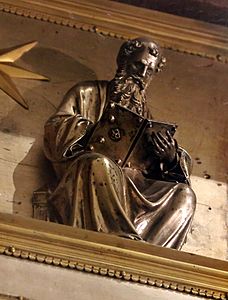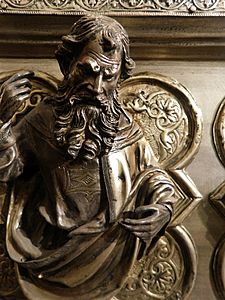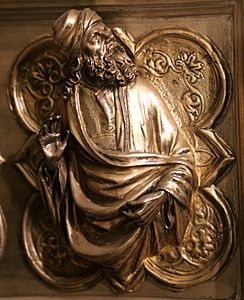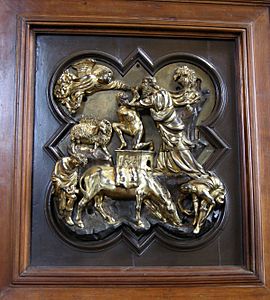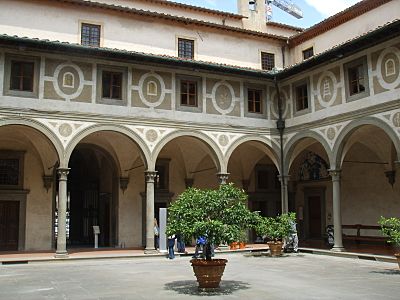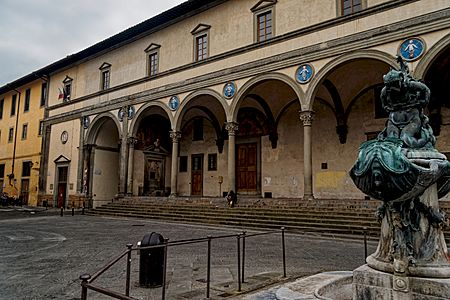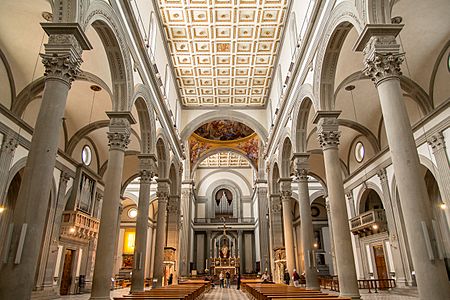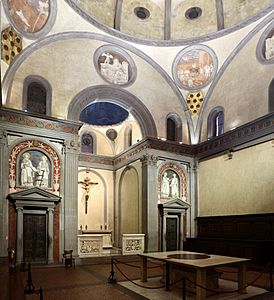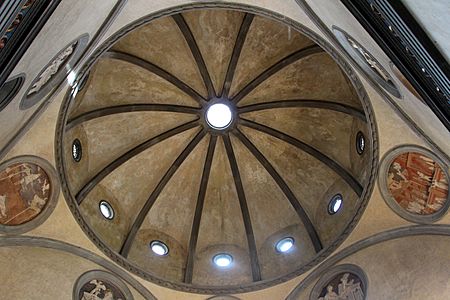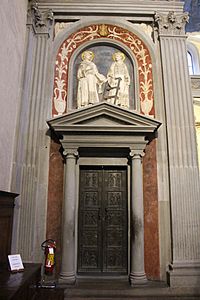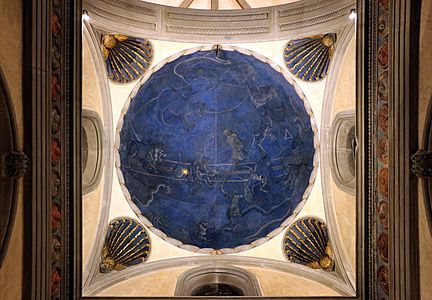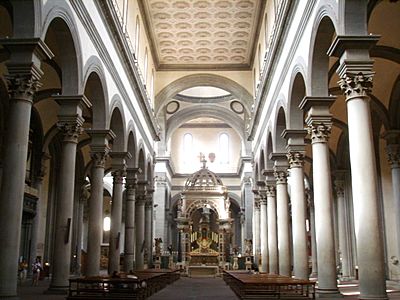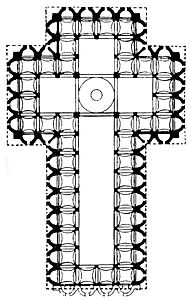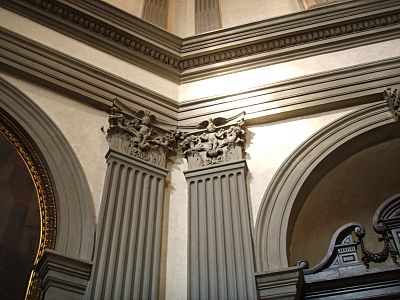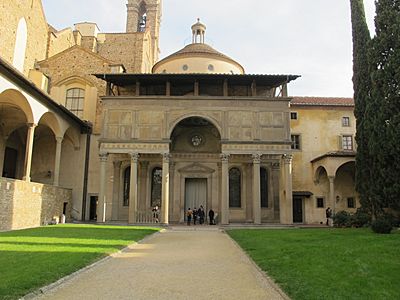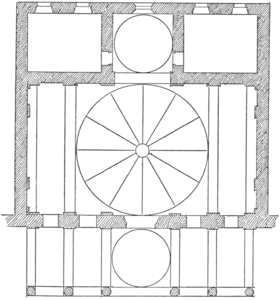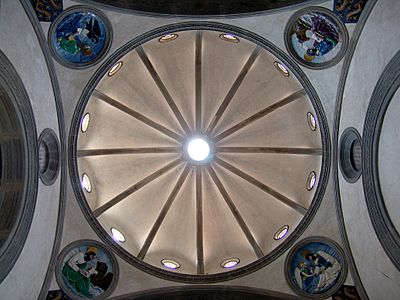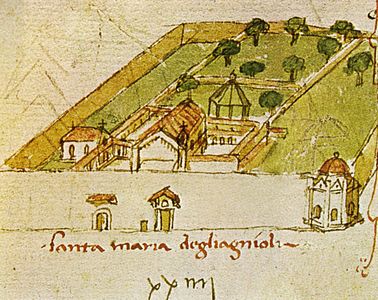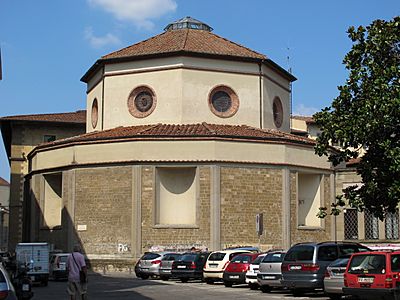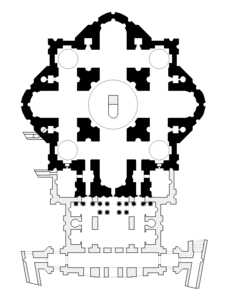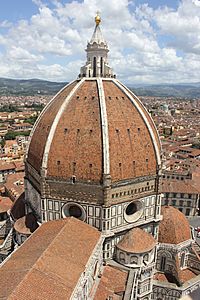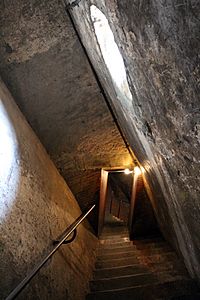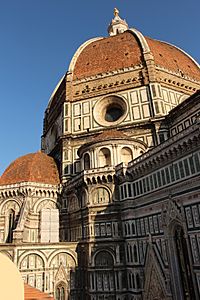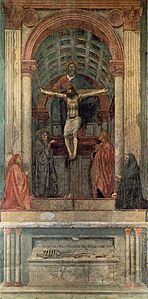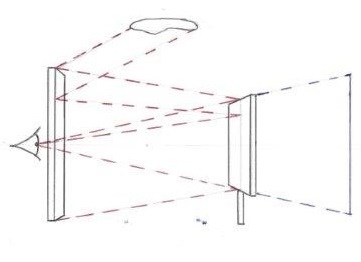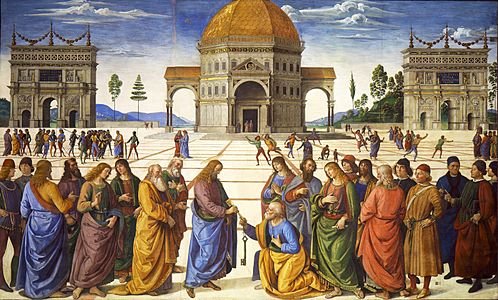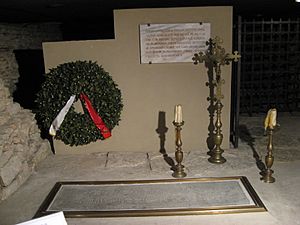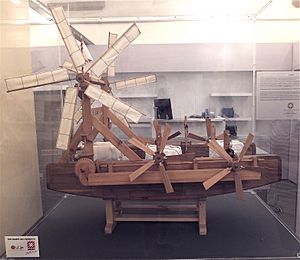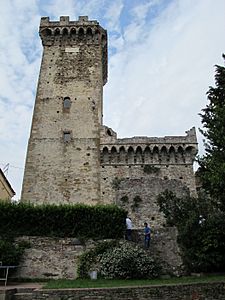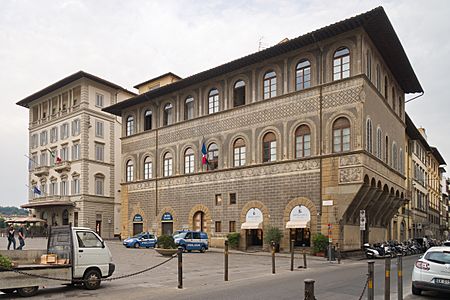Filippo Brunelleschi facts for kids
Quick facts for kids
Filippo Brunelleschi
|
|
|---|---|
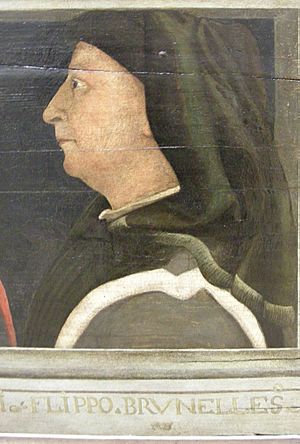
Filippo Brunelleschi in an anonymous portrait of the 2nd half of the 15th century (Louvre, Paris)
|
|
| Born |
Filippo di ser Brunellesco di Lippo Lapi
1377 Florence, Republic of Florence
|
| Died | 15 April 1446 (aged 68–69) Florence, Republic of Florence
|
| Known for | Architecture, sculpture, mechanical engineering |
|
Notable work
|
Dome of Santa Maria del Fiore |
| Movement | Early Renaissance |
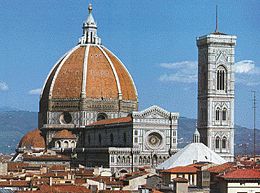
Filippo Brunelleschi (/ˌbruːnəˈlɛski/ BROO-nə-LESK-ee, Italian: [fiˈlippo brunelˈleski], also known as Pippo; 1377 – 15 April 1446), was an Italian architect, designer, and sculptor. He is most famous for designing the dome of the Florence Cathedral. His principal surviving works can be found in Florence.
Brunelleschi's interests included mathematics and engineering. He invented hydraulic machinery and elaborate clockwork, none of which survives.
Contents
Early life
Brunelleschi was born in Florence, Italy, in 1377 to affluent parents, Brunellesco di Lippo (born c. 1331) and Giuliana Spini. His father was a notary and civil servant. Brunelleschi had two brothers.
The young Filippo received a literary and mathematical education. At the age of fifteen, he was apprenticed to the Arte della Seta, the wool merchants' guild, the wealthiest and most prestigious guild in the city, which also included jewellers and metal craftsmen. In December 1398, he became a master goldsmith and a sculptor working with cast bronze.
Sculpture – Competition for the Florence Baptistry doors
In 1401, the city of Florence held a competition for the design of new sculpted and gilded bronze doors for the Florence Baptistery. Brunelleschi and another young sculptor, Lorenzo Ghiberti, took part in the competition. Each sculptor was required to produce a single bronze panel, depicting the Sacrifice of Isaac within a Gothic four-leaf frame. The head of the jury was Giovanni di Bicci de' Medici. The jury publicly praised Ghiberti's panel before they had seen the finished work of Brunelleschi, but when they saw it, they were unable to choose between the two and suggested that they collaborate on the project. Brunelleschi refused to forfeit total control of the project, preferring it to be awarded to Ghiberti.
Brunelleschi would eventually abandon sculpture and devote his attention entirely to architecture and optics, but continued to receive sculpture commissions until at least 1416.
-
St. John the Evangelist, Altar of Saint at Church of San Zeno, Pistoia (1399–1400)
The Foundling Hospital (1419–1445)
Brunelleschi's first architectural commission was the Ospedale degli Innocenti (1419–c. 1445), or Foundling Hospital, designed as a home for orphans. Brunelleschi was the official architect until 1427, but he was rarely on the site after 1423. The hospital was completed by the Florentine architect Francesco della Luna in 1445.
The major portion completed by Brunelleschi was an arcade or loggia with nine arches. The arcade was supported by slender columns with Corinthian capitals. This first arcade, with its columns, rounded arches and simple classical decoration, became the model for a long series of Renaissance buildings across Europe. Its long loggia would have been a rare sight in the tight and curving streets of Florence, not to mention its impressive arches, each about 8 m high. The building was dignified and sober, with no displays of fine marble or decorative inlays. It was also the first building in Florence to make clear reference—in its columns and capitals—to classical antiquity.
Soon, other commissions came, such as the Ridolfi Chapel in the church of San Jacopo sopr'Arno, now lost, and the Barbadori Chapel in Santa Felicita, also modified since its building. For both, Brunelleschi devised elements already used in the Ospedale degli Innocenti, and which would also be used in the Pazzi Chapel and the Sagrestia Vecchia. At the same time, he was using such smaller works as a sort of feasibility study for his most famous work, the dome of the Cathedral of Florence.
Basilica of San Lorenzo (1421–1442)
The Basilica of San Lorenzo was his next great project, undertaken soon after he began the Foundling Hospital. It was the largest church in Florence, sponsored by the Medici family, whose tombs were located there, and it was the work of several different architects, including, later, Michelangelo. The parts undertaken by Brunelleschi were the central nave, with the two collateral naves on either side bordered by small chapels, and the old sacristy.
One practice of Brunelleschi in the Old Sacristy, which later became a doctrine of Renaissance architecture, was the use of white walls in churches.
-
Vault of the Old Sacristy (Sagrestia vecchia), with the tomb of Giovanni di Bicci de' Medici
Basilica of Santo Spirito (1434–1466)
The Basilica of Santo Spirito in Florence was his next major project, which he carried out in parallel with his other major works. Though he began designing in 1434, construction did not begin until 1436, and continued beyond his lifetime. The columns for the facade were not delivered until 1446, ten days before his death, and the facade was not completed until 1482, and then was modified in the 18th century. The bell tower was also a later addition.
Santo Spirito is an example of the mathematical proportion and harmony of Brunelleschi's work.
Pazzi Chapel (1430–1444)
The Pazzi Chapel in Florence was commissioned in about 1429 by Andrea Pazzi to serve as the Chapter House, or meeting place of the monks of the Monastery of Santa Croce. The building was not entirely finished until about 1469, twenty years after his death. Some of the details, such as the lantern on top of the dome, were added after his death.
The portico of the chapel is especially notable for its fine proportions, simplicity, and harmony. Light comes downward from the circular windows of the dome, and changes throughout the day. The architecture of the chapel is based on an arrangement of rectangles, rather than squares, which makes it appear slightly less balanced than his chapel in the Old Sacristy of San Lorenzo.
-
Interior of the Pazzi Chapel with sculptural plaques by Luca Della Robbia
Santa Maria degli Angeli (1434–1437)
Santa Maria degli Angeli was an unfinished project by Brunelleschi. The financing of the church came from the legacy of two Florentine merchants, Matteo and Andrea Scolari, and construction commenced in 1434. However, in 1437, the money for the church was seized by the Florentine government to help finance a war against the neighboring city of Lucca. The structure, which had reached a height of 7 m (23 ft), was never completed as Brunelleschi designed it. The completed part was later integrated into a later church of a different design.
The plans and model of Brunelleschi's church disappeared, and it is known only from an illustration in the Codex Rustichi from 1450, and from drawings of other architects.
-
Michelangelo's plan for Saint Peter's Basilica, Rome (1546), superimposed on the earlier plan by Bramante
Florence Cathedral dome (1420–1461)
Santa Maria del Fiore was the cathedral and symbol of Florence, which had been begun in 1296. After the death of the first architect, Arnolfo di Cambio, work was interrupted for fifty years. The campanile, or bell tower, was added by Giotto soon after 1330. Between 1334 and 1366 a committee of architects and painters made a plan of a proposed dome, and the constructors were sworn to follow the plan. The proposed dome from the base to the lantern on top was more than 80 m (260 ft) high, and the octagonal base was almost 42 m (138 ft) in diameter. It was larger than the dome of the ancient Pantheon, or any other dome in Europe, and no dome of that size had been built since antiquity.
A competition was held in 1418 to select the builder. It was won by Brunelleschi, with the help of a brick scale model of the dome made for him by his friend the sculptor Donatello.
The work on the dome (built 1420–1436), the lantern (built 1446–c. 1461) and the exedra (built 1439–1445) occupied most of the remainder of Brunelleschi's life. Brunelleschi's success can be attributed to his technical and mathematical genius. Brunelleschi used more than four million bricks in the construction of the octagonal dome. Notably, Brunelleschi left behind no building plans or diagrams detailing the dome's structure; scholars surmise that he constructed the dome as though it were hemispherical, which would have allowed the dome to support itself.
Brunelleschi constructed two domes, one within the other, a practice that would later be followed by all the successive major domes, including those of Les Invalides in Paris and the United States Capitol in Washington.
Brunelleschi invented a new hoisting machine for raising the masonry needed for the dome. This hoisting machine would be admired by Leonardo da Vinci years later.
The strength of the dome was improved by the wooden and sandstone chains invented by Brunelleschi, which acted like tensioning rings around the base of the dome and reduced the need for flying buttresses, so popular in Gothic architecture.
Brunelleschi kept his workers up in the building during their breaks and brought food and diluted wine, similar to that given to pregnant women at the time, up to them. He felt the trip up and down the hundreds of stairs would exhaust them and reduce their productivity.
Once the dome was completed, a new competition was held in 1436 for the decorative lantern on top of the dome. Brunelleschi won the competition and designed the structure and built the base for the lantern, but he did not live long enough to see its final installation atop the dome.
Accomplishments
Linear perspective
Besides his accomplishments in architecture, Brunelleschi is also generally credited as the first person to describe a precise system of linear perspective. This revolutionised painting and opened the way for the naturalistic styles of Renaissance art. He systematically studied exactly how and why objects, buildings, and landscapes changed and lines appeared to change shape when seen from a distance or from different angles, and made drawings of the Baptistry in Florence, Place San Giovanni and other Florence landmarks in correct perspective.
According to his early biographer Antonio Manetti, between 1415 and 1420, Brunelleschi conducted a series of experiments. He made paintings with correct perspective of the Florence Baptistery and the Palazzo Vecchio. Brunelleschi used a grid or set of crosshairs to copy the exact scene square by square, and produced a reverse image. The results were compositions with accurate perspective, as seen through a mirror. To compare the accuracy of his image with the real object, he made a small hole in his painting, and had an observer look through the back of his painting to observe the scene. A mirror was then raised, reflecting Brunelleschi's composition, and the observer saw the striking similarity between the reality and painting. Both panels have since been lost.
-
The Holy Trinity by Masaccio (1425–1427) used Brunelleschi's system of perspective
-
The Delivery of the Keys fresco, 1481–1482, Sistine Chapel, by Perugino (1481–1482), features both linear perspective and Brunelleschi's architectural style
Other activities
Brunelleschi designed machinery for use in churches during theatrical religious performances that re-enacted Biblical miracle stories. Contrivances were created by which characters and angels were made to fly through the air in the midst of spectacular explosions of light and fireworks. It is not known for certain how many of these Brunelleschi designed, but at least one, for the church of San Felice, is confirmed in the records.
Brunelleschi also designed fortifications used by Florence in its military struggles against Pisa and Siena. In 1424, he was working in Lastra a Signa, a village protecting the route to Pisa, and in 1431, in the south of Italy on the walls of the village of Staggia. These walls are still preserved.
Personal life
Brunelleschi did not have children of his own, but in 1415, he adopted Andrea de Lazzaro Cavalcanti, who took the name Il Buggiano, after his birthplace. He was Brunelleschi's sole heir.
Interesting facts about Filippo Brunelleschi
- Brunelleschi is considered to be a founding father of Renaissance architecture.
- As a child, he intended to follow in the footsteps of his father and become a notary or a civil servant.
- Brunelleschi's earliest sculptures are two small bronze statues of evangelists and saints (1399–1400) made for the altar of the Crucifix Chapel Pistoia Cathedral.
- In 1402, Brunelleschi visited Rome (possibly with his friend, the sculptor Donatello) to study its ancient ruins. The trip had a profound impact on Brunelleschi and influenced his building designs.
- In 1421, Brunelleschi became the first person to receive a patent in the Western world for inventing a river transport vessel. It was intended to be used to transport marble.
- Brunelleschi's body lies in the crypt of the Cathedral of Florence. Inside the cathedral entrance is this epitaph: "Both the magnificent dome of this famous church and many other devices invented by Filippo the architect, bear witness to his superb skill. Therefore, in tribute to his exceptional talents, a grateful country that will always remember him buries him here in the soil below." A statue of Brunelleschi, looking up at his dome, was later placed in the square in front of the cathedral.
- Brunelleschi is portrayed by Alessandro Preziosi in the 2016 television series Medici: Masters of Florence.
Principal works
The principal buildings and works designed by Brunelleschi or which included his involvement, all situated in Florence:
- Dome of the Florence Cathedral (1419–1436)
- Ospedale degli Innocenti (1419–ca.1445)
- The Basilica of San Lorenzo (1419–1480s)
- Meeting Hall of the Palazzo di Parte Guelfa (1420s–1445)
- Sagrestia Vecchia, or Old Sacristy of S. Lorenzo (1421–1440)
- Santa Maria degli Angeli: unfinished, (begun 1434)
- The lantern of Florence Cathedral (1436–ca.1450)
- The exedrae of Florence Cathedral (1439–1445)
- The church of Santo Spirito (1441–1481)
- Pazzi Chapel (1441–1460s)
See also
 In Spanish: Filippo Brunelleschi para niños
In Spanish: Filippo Brunelleschi para niños


